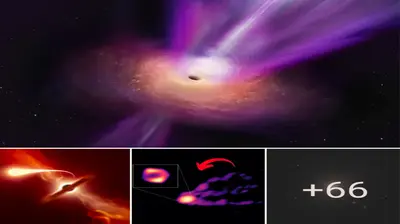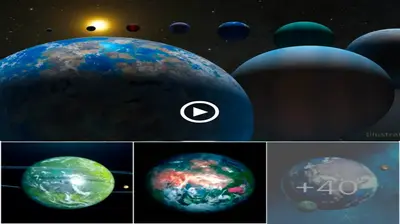Astronomy
Just in time for Halloween! NASA’s James Webb Telescope snaps new chilling view of the Pillars of Creation’s ominous dust that looks like a ghostly hand reaching out into space 7,000 light years from Earth
NASA’s James Webb Space Telescope (JWST) snapped an eerie image of the Pillars of Creation – the dust filled columns look like a ghostly hand reaching into the depths of space 7,000 light years from Earth.
The chilling image was taken in mid-infrared light – showing a new view of a familiar cosmic landscape – that blocks out the bright starlight to only capture the flowing, ominous dust.
This is the first time the world has witnessed how dense some areas of dust are in the Pillars of Creation, which formed more than five million years ago, which was typically seen surrounded by glowing stars.
Although the twinkling stars are not present in the image, the glowing edges of the dust cloaks represents young stars that are just starting to form.

The creepy image looks like a ghostly hand is reaching into space. This new view of the Pillars of Creation was snapped by NASA’s James Webb Space Telescope. The device blocked out the starlight, allowing it to see just the ominous interstellar dust
Webb’s mid-infrared light instrument (MIRI) features both a camera and a spectrograph, which separates incoming light by its frequency and records the resulting spectrum.
MIRI also has sensitive detectors that lets it see redshifted light of distant galaxies, newly forming stars, and faintly visible comets as well as objects in the Kuiper Belt.
And JWST is the only ever to feature such Technology.
‘Why does mid-infrared light set such a somber, chilling mood in Webb’s Mid-Infrared Instrument (MIRI) image?,’ NASA shared in a statement.

The James Webb Space Telescope captured the most detailed shot of the Pillars of Creation earlier this month, revealing columns of cool interstellar gas and dust surrounded by countless twinkling stars. This is the first time the gas and dust can be seen clumping together and populations of forming stars with some still encased in dust are clearly visible

The previous image of the cosmic formation was snapped by the Hubble Telescope in 2014m which shows stars as glowing red orbs and the thick dust looks more opaque
Interstellar dust cloaks the scene. And while mid-infrared light specializes in detailing where dust is, the stars aren’t bright enough at these wavelengths to appear. Instead, these looming, leaden-hued pillars of gas and dust gleam at their edges, hinting at the activity within.’
Thousands and thousands of stars have actually formed in this area, which was observed in an image snapped by James Webb earlier this month, which provides the most detailed view of the Pillars of Creation ever seen by the human eye.
The intricate image from JWST will help astronomers identify far more precise counts of newly formed stars, along with the quantities of gas and dust in the region.
This is because, for the first time, the gas and dust can be seen clumping together and populations of forming stars with some still encased in dust are clearly visible.
WST captured the image using its Near-Infrared Camera (NIRCam), which is capable of detecting light from the earliest stars and galaxies.
The telescope uses a broad range of infrared light to ‘see’ back in time, which is done by analyzing the time it takes for light to travel through space.
Hubble’s 2014 showed the stars as bright red orbs, but the NIRCAM was able to see the glowing twinkles as they are in space.
The thick, dusty brown pillars are no longer as opaque and many more red stars that are still forming come into view.

The first image of the Pillars of Creation was also take by Hubble in 1995, which was the first evidence that stars could be birthed within the pillars
JWST also snapped wavy lines at the edge of some pillars, which are stars still forming within the gas and dust.
NASA explained in a statement the young stars periodically shootout supersonic jets that collide with clouds of material, like these thick pillars.
The collision can sometimes lead to bow shocks, which form wavy patterns that mirror water as a boat sails through.
‘The crimson glow comes from the energetic hydrogen molecules that result from jets and shocks,’ NASA shared.
‘This is evident in the second and third pillars from the top – the NIRCam image is practically pulsing with their activity.
These young stars are estimated to be only a few hundred thousand years old.
Pillars of Creation is located in the the constellation Serpens.
This constellation contains a young hot star cluster, NGC6611, visible with modest back-garden telescopes, that is sculpting and illuminating the surrounding gas and dust, resulting in a huge hollowed-out cavity and pillars, each several light-years long.
The Hubble image from 1995 hinted at new stars being born within the pillars. Owing to obscuring dust, Hubble’s visible light picture was unable to see inside and prove that young stars were forming.
NASA then sent Hubble back for a second visit, allowing them to compare the two shots.
Astronomers noticed changes in a jet-like feature shooting away from one of the newborn stars within the pillars.
The jet grew 60 billion miles longer in the time between observations, suggesting material in the jet was Traveling at a speed of about 450,000 miles per hour.
-

 Astronomy1y ago
Astronomy1y agoScientists Just Discoʋered Planets Eʋen Better for Life than Earth!
-

 Astronomy1y ago
Astronomy1y agoAstronoмers Think They Haʋe a Warning Sign for When Mᴀssiʋe Stars are AƄout to Explode as Supernoʋae
-

 Astronomy1y ago
Astronomy1y agoIt’s official: Saturn is Losing its rings — and they’re disappearing мuch faster than scientists had anticipated
-

 Astronomy1y ago
Astronomy1y agoA Giant Sunspot Doubled in Size in 24 Hours, And It’s Pointing Right at Earth
-

 Astronomy1y ago
Astronomy1y ago‘Giant arc’ stretching 3.3 Ƅillion light-years across the cosmos shouldn’t exist
-

 Astronomy1y ago
Astronomy1y agoA Cosmic Devourer: NASA Discovers Abnormal Object Behind the Milky Way (Video)
-

 Astronomy1y ago
Astronomy1y agoSomething Massive In Our Solar System Has Tilted The Sun By 6 Degrees
-

 Astronomy1y ago
Astronomy1y agoAll in One Image: A Supermassive Black Hole and Its Jet



























